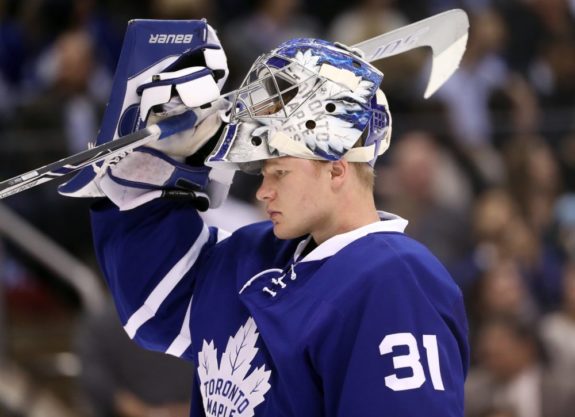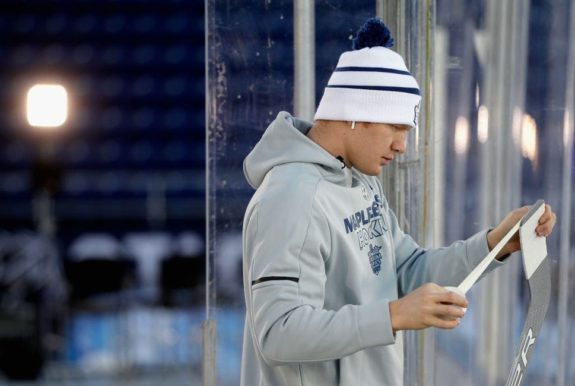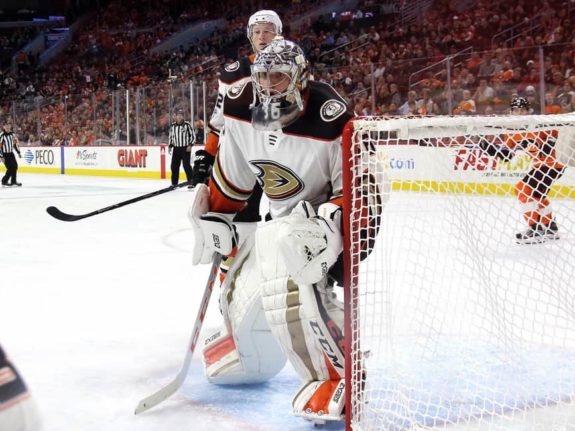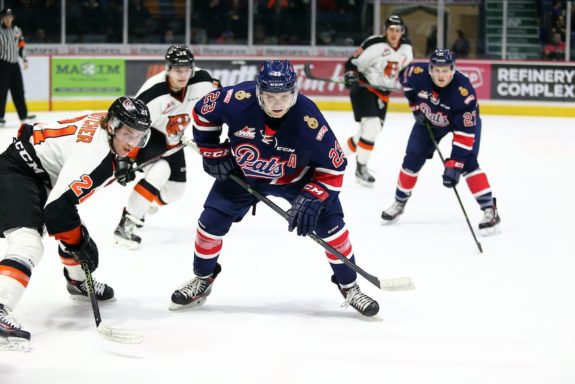It was Jun. 20, 2016, when the Toronto Maple Leafs made a trade with the Anaheim Ducks that would change the complexion of their lineup – for both the present day roster and their short-term plans. And boy, did it ever kickstart their development.
You see, it was then when the Leafs acquired their current starting goaltender in Frederik Andersen. In return, the Leafs sent the Ducks a 2016 first-round pick and a second-round pick in the 2017 NHL Entry Draft.

Seeing that Andersen was a pending restricted free agent (RFA) at the time of the trade, the Leafs quickly locked him up long-term by signing the goaltender to a five-year deal worth $25 million. The contract came with an annual average value (AAV) of $5 million. On top of that, the contract came with a modified no-trade clause which likely meant that Andersen would remain with the Leafs long-term.
From there, the Leafs very quickly turned things around. They drafted Auston Matthews and promoted William Nylander and Mitch Marner and things were suddenly looking up for a team that had just finished at the bottom of the league one year prior.
But considering the importance of the pieces that both teams received in the deal, here’s a look at how both clubs were impacted following the deal.
Real Deal Freddy Andersen
At the time of his acquisition, Andersen was just 26 years old. He had already notched a 30-win season with the Ducks in 2014-15 recording 35, and his record through his first 125 regular season games was impressive. While a member of the Ducks, he finished with a record of 77-26-12 with a .918 save percentage and 2.33 goals against average and he carried that through to his debut season with the Leafs.
In 2016-17, his first year with the Leafs, he played in 66 games for the storied franchise. He posted a 33-16-14 record for the team with a .918 SV% and 2.67 GAA and quickly solidified his place as the Leafs starting goaltender.
Related: Andersen – The Underrated Vezina Candidate
In fact, not only did he impress in the regular season, but he helped lead the Leafs back to the playoffs (along with the help of their rookies) where they played the Presidents’ Trophy winning Washington Capitals and took them to six games. But postseason hockey wasn’t new to Andersen. He already had 28 games of playoff experience through his first three seasons with the Ducks. Still, his ability to perform against the Caps made him even more popular in a city that thrives on their Maple Leafs’ success.

Now, Andersen is on the verge of playing 60 games again for the Leafs this season and will likely surpass his own win total from his first year in Toronto. In fact, he’s just three wins away from setting a career high for himself.
But with the Leafs having lost Matthews for a number of games this season due to injury, the team has relied heavily on their goaltending to get them to where they are. And Andersen has answered the bell. He has a .919 save percentage, which is slightly higher than his career number, and a 2.78 goals against average. He’s already set a career high in shutouts and leads the league in shots against and wins when facing 40 or more shots.
While the Andersen acquisition was a major one for the Leafs, he was just one piece of the puzzle in jump starting the Leafs rebuild – which is still in just its second year of what team President – Brendan Shanahan – called a five-year plan.
On top of that, considering what the Leafs gave up for the goaltender, it wasn’t a very steep price to get your team a starting goalie. But the Ducks needed to make a decision one who would be their starting goalie and they handed the net to John Gibson with this trade.
Gibson Guarding the Ducks’ Cage
As for the Ducks, not only did they acquire the two draft picks, but they locked down their own starting goalie – Gibson. While the 24-year-old has dealt with a number of injury setbacks over his short career, he has put up impressive numbers when he is on the ice. He’s played 167 games for the Ducks over parts of five seasons with an 87-52-19 record to show for it. He has a career .923 save percentage and 2.29 goals against average.

You see, the Ducks would’ve more than likely lost one of these two goaltenders when the Vegas expansion draft occurred this past summer had they held on to both. Instead, they moved Andersen and got two picks to show for it.
Originally a Pittsburgh Penguins pick, the 2016 first-round pick the Leafs moved to the Ducks ended up as the 30th overall pick in the draft. Anaheim used it to take a forward prospect named Sam Steel out of the Regina Pats organization in the WHL. In Dec. 2016, the Ducks signed him to a three-year entry-level contract.
Steel has 332 points in 254 games with the Pats over parts of five seasons in the WHL and is a bright spot in the Ducks’ future plans.

As for the 2017 second-round pick, the Ducks used it to take Maxime Comtois with the 50th overall pick. Comptois has tallied 187 points in 176 games with the QMJHL’s Victoriaville Tigres over three seasons, and joined Steel with Canada’s World Junior team this past year. Both will be major pieces for the team if their junior play is any indication of what they can do at the NHL level when they take that next step.
On top of what can be determined from their junior success, the Ducks do have a strong history of late first round picks. They grabbed Corey Perry with the 28th overall pick, Kyle Palmieri at 26th, Rickard Rakell at 30th and Shea Theodore at 26th. Even Gibson himself was picked just shy of the first round at 39th overall. With that in mind, time will tell if these two players will be added to that list.
No Clear Winner
Regardless of who performs better in the long-run, the Ducks have to live with their decision to run with Gibson. And as of now, it’s proving to be a win-win for both teams. The Leafs, as mentioned, jump started their rebuild with the acquisition of a proven starter in net and his statistics since the trade have certainly pleased the team’s brass.
As for the Ducks, they not only solidified their starter in net and provided him with a new level of confidence, but they added to their prospect pool in the process with two high-touted CHL players in Comtois and Steel.
While it will take more time to crown a winner in this trade, one thing is for sure at the moment. Both the Leafs and the Ducks have bright futures ahead of them and it should be fun watching them unfold.